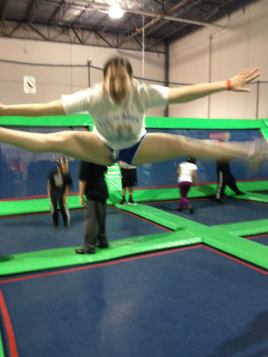The most important thing I’ve done for myself in recent months is get a healthy amount of exercise on a regular basis. And I’ll let you in on a secret: it wasn’t hard. At all. In fact, it’s my favorite part of my routine, which makes all the difference in the world.
Fitness, diet, and overall health is something I’ve struggled with for as long as I can remember. I’ve never had an issue with exercise, but the hardest part was always getting up and actually doing it. To make things trickier, I don’t have a sweet tooth. I have sweet teeth; 32 of them to be exact, and they’re absolutely relentless. Combining the two, getting healthy was always a mighty chore that I just didn’t have time for. Procrastination for me consisted of a date with cookies, Netflix, and a lot of blankets. And so when I finally got to the backed up work that had to be done, I’d tell myself I had no time to hit the gym.
A little over two months ago, I stumbled upon some classes my school fitness center was offering. A brand new facility opened in November with state-of-the-art everything, but the newness faded pretty quickly and what was cool for a month turned back into a huge room full of treadmills that didn’t interest me. When I forced myself to go after class one day, I found a flier for classes that I had never seen before; Contemporary Dance, Beyoncé Booty Barre (as cool as it sounds), all sorts of styles of yoga, etc. I ventured out to the next class and the rest is history.
The classes I began to take completely revolutionized the way I started to think about fitness. I’d come home energized and excited and – somehow – counting down the days until my next class. Each one brought to the table something that really made me happy – even better than Netflix and food and laziness. Of course, extracurricular activity and schoolwork do take up a decent chunk of my week and sometimes a little TV time is absolutely essential to my well-being.
The biggest change happened when I realized that all of this counted as exercise. I’d grown so exhausted and fatigued by that word that I was at a point where I couldn’t ever imagine it was something I could love. It hit me that exercise shouldn’t be a chore, it should be a part of your routine that you look forward to. Not “I have to exercise today” but “I get to exercise today”. There’s a reason why most children don’t need to worry about “getting exercise”; it’s because running around and playing outside is their exercise. No need to look at it as a chore if you’re having fun. There are countless ways to incorporate exercise into your schedule without thinking of it as a task. To name a few:
– Dance classes. The Beyoncé Booty Class is my new favorite; We spend a portion of the class on a barre warm-up, a portion learning a routine, and a portion sculpting workouts exclusively focusing on our lower halves – entirely to Beyoncé songs. It’s empowering and a major confidence booster. Check local studios and gyms for unique dance-oriented classes.
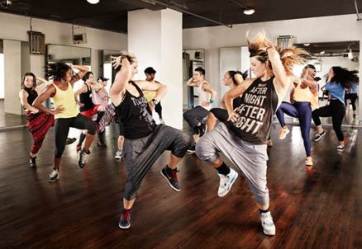
– Rock Climbing. Indoor or outdoor, whatever floats your boat – just make sure you’re doing it safely!
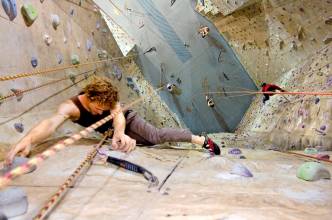
– Hiking.

– Trampolining. This was one of my all time favorite activities as a kid and it’s still secretly one of my favorite things to do. Plus, now they have actual indoor “trampoline parks”, where you can bounce around for your allotted amount of time which is quite the workout, if you can imagine.

– Indoor Surfing. Heard about this from a friend, still haven’t tried it yet. Essentially you’re put in a room on an electronic surfboard with screens of waves surrounding the room. As the surfboard moves, you maintain different postures and positions to improve muscle definition and balance. Sounds great for those who just can’t get to a beach any time soon.
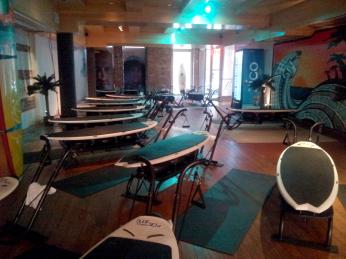
– Hula-hooping. Channel your inner-child: they have classes for this, too.

– Yoga. One that recently caught my attention is called Anti-Gravity yoga, where you activate your core and engage in different stretches while suspended from a hammock-like cloth on the ceiling.
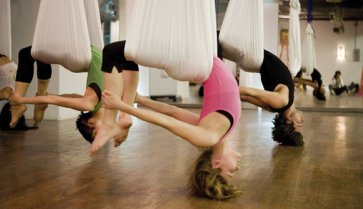
– Walking the beach. So maybe this isn’t necessarily available to everyone, but if you’re fortunate enough to live near a body of water, it can be a major way to energize for the day; I like to do it if I’m up early enough. Nothing like the sound of the waves to start your day.

At the end of the day, you can do all of these or none of these. Some people might love the machines at the gym and that’s awesome. Essentially, I’ve found that the most important thing is just to love what you do; the sooner you stop thinking chore and start thinking fun, the sooner you’ll find a healthier and happier lifestyle.
Here’s a picture of me trampolining. It was tons of fun, I recommend it!
